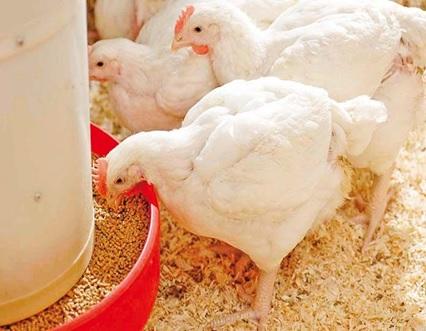Energy - one of the most elusive and expensive nutrient for poultry
Published: January 31, 2023
By: Dr. Shivi Maini, General Manager Technical, Indian Herbs Specialities

Prologue
Energy is the most elusive nutrient in poultry diets. Simply reducing the energy content in poultry feed may not be a viable option for cost-saving in feed formulation.
An economical solution is to enable efficient energy utilization; another option is to reduce the energy value to partial extent while maintaining bird’s performance is the dietary supplementation of suitable additives. In this context, Indian Herbs Specialities took the initiative to evaluate energy repartitioning advantage of natural choline supplement, BioCholine.
An economical solution is to enable efficient energy utilization; another option is to reduce the energy value to partial extent while maintaining bird’s performance is the dietary supplementation of suitable additives. In this context, Indian Herbs Specialities took the initiative to evaluate energy repartitioning advantage of natural choline supplement, BioCholine.
Introduction
Amongst all nutrients, energy is one of most expensive nutrient in poultry feed. Feed has always been the biggest production cost faced by poultry farmers and recent rises in global prices, combined with supply volatility, mean that producers are now having to look harder for ways to maintain their margins. The challenge for everyone involved in poultry production is to feed birds with a balanced diet, at the lowest cost, yet still produce animal protein that meet the customer’s requirements to maximize farm profitability and meet environmental and animal welfare standards. Feed represents the major cost of animal production, constituting up to 70 percent of the total. Protein, fat and starch provide energy for maintenance, growth and production. In feed formulation, improving feed efficiency and reducing cost per kilogram of carcass meat yield are the major goals of nutritionists. Of total feed cost, about 95 percent is used to meet energy and protein requirements, about 3-4 percent for major mineral, trace mineral and vitamin requirements, and 1-2 percent for various feed additives and energy source is the largest component of poultry diets. Simply reducing the energy content in poultry feeds may not be a viable option for cost-saving in feed formulation. Energy is one the most limiting factor in the feed and lowering energy will result in increased feed conversion. An economical solution is to enable efficient energy utilization; another option is to reduce the energy value to partial extent while maintaining bird’s performance is the dietary supplementation of suitable additives. Those additives that can provide energy sprang effect. In this context, a number of studies are conducted where supplementing phytogenic additives have shown to provide energy repartitioning effect and therefore sparing energy of upto 60-70 kcal/kg in starter, grower and finisher diets.

Choline: The conditionally essential nutrient with critical metabolic role
Choline is well known for its nutritional advantages since last 10 decades and the advantages of choline supplementation in monogastrics are well known. Choline is a quasi-vitamin and its dietary supplementation improves feed efficiency besides helping to prevent fatty liver in birds. Choline is known to optimize energy metabolism, to control fatty liver syndrome (FLS) and reduces body fat. It is indispensable for efficient nutrient assimilation and hepatic fat metabolism. Natural choline supplement BioCholine contains highly bioavailable choline in conjugated form of phosphatidylcholine alongwith other phospholipids and PUFA.
BioCholine is natural, stable, non-hygroscopic and non-corrosive. Since phosphatidylcholine is readily and highly bioavailable through BioCholine, it does not need intermediate steps and is readily available source for VLDL formation thereby regulating hepatic lipid pathways. Phosphatidylcholine acts as an agonist (promoter) of Peroxisome Proliferator Activated Receptors Alpha (PPARα), proteic nuclear receptors acting on transcription processes. PPARα are present both in the intestine and in the liver, indicating that natural choline (phosphatidylcholine) begins to act in the enterocytes and later, in the liver, optimizing the absorption of nutrients in the diets and improving feed conversion and other productive parameters.
PPAR-α : the key nutritional sensor for metabolic adaptation
PPARα functions as lipid sensor in the liver and recognizes and responds to the influx of fatty acids by stimulating the transcription of specific genes. Studies performed using in poultry models and PPAR-α–null mice (knockout mice) demonstrated that PPAR-α controls the expression of numerous genes related to lipid metabolism in the liver, including genes involved in mitochondrial β-oxidation, peroxisomal β-oxidation, fatty acid uptake and binding, and lipoprotein assembly and transport. The PPARα regulate the expression of specific genes implicated in metabolic reactions, such as beta oxidation of fatty acids and regulation of energetic homeostasis due to the secretion of adiponectin. Adiponectin is an adipokine and protein hormone that influences several metabolic functions including glucose and lipid metabolism, glucose utilization and lipogenesis. It is reported that adiponectin has a direct effect on regulating metabolic pathways in the liver thereby improving nutrient utilization and body weight gain.
BioCholine – the energy repartitioning agent
In relation to the effect of different sources of choline on the chicken’s performance, a group of researchers reported about benefits of supplementing BioCholine to improve weight gain, feed efficiency and decreased mortality in poultry and swine models. Researchers (Kim et al., 2018) reported about BioCholine advantage to efficiently upregulate expression of PPARα and significantly improved activity of Adiponectin hormone in poultry broilers. BioCholine supplementation to broilers (0-42 day) significantly upregulated key allosteric effectors of hepatic fat and energy metabolism. Kim et al., 2018 also reported about the role of BioCholine on growth response in poultry broiler. BioCholine at a significantly lower level of inclusion produced significant improvement in the zootechnical performance of broiler chicken and expressed differentially genes related to the hepatic lipogenic, hepatic lipid catabolic pathway and energy metabolic pathway. In a research study at University of Georgia, USA, it is validated that BioCholine has extra advantage of energy repartitioning agent. Supplementation of BioCholine at a lower dosage to completely replace 60% 1 kg choline chloride in broiler ration lead to significant upregulation of marker gene effectors (PK and PEPCK) of glucose pathway.
Hepatic mRNA Expression of Pyruvate Kinase (PK) gene: Glycolytic pathway is a fundamental system for energy metabolism. Liver predominantly converts pyruvate, a glycolytic product, into fatty acid via Acetyl CoA. Pyruvate Kinase is a rate limiting glycolytic enzyme and catalyses the formation of pyruvate and ATP from phosphoenolpyruvate (PEP) and ADP. With the supplementation of BioCholine in broilers, Pyruvate Kinase (PK) gene expression was significantly upregulated (+159.51%). This validates advantage of BioCholine in efficient energy utilization.
Hepatic mRNA Expression of PEPCK: Gluconeogenesis is an important metabolic pathway for endogenous glucose generation from substrates such as lactic acid and gluconeogenic amino acids. PEPCK is an important gene, regulating growth by gluconeogenic mechanism/protein deposition in broilers. Trial finding suggest that BioCholine supplementation upregulated hepatic gluconeogenic gene expression, methionine metabolism and epigenetic gene expression, which involve miRNA-mediated post-transcriptional mechanism. PEPCK was found to be upregulated in the broilers supplemented BioCholine (+47.68%). PEPCK gene promoter was found to be hypermethylated in Biocholine supplemented birds that increases the utilization of amino acids and glucose in growth and muscle formation.
Based on scientific validation reported by Kim et al., 2018, further studies were undertaken by group of EU - researchers who determined effect of BioCholine on the diet’s apparent metabolizable energy (AME) in growing chicken and rooster. The objective of these experiments was to determine the efficacy of BioCholine on the diet’s AME content. Researchers reported that BioCholine supplementation produced improvements in the use of gross energy (GE), translating into an increase in the diet’s AME content. The improvement ranged from 60 kcal/kg (chickens) to 88 kcal/kg (roosters), at a significantly lower rate of inclusion of BioCholine (for more details of experimental findings and BioCholine dosage please contact author).
Summary
In recent years, choline supplementation from natural origin / phytogenics has emerged as an alternative to choline chloride, the standard ingredient used in the animal production industry. BioCholine, the natural choline supplement is a global brand that is widely being used in poultry and swine diets across 50+ countries. Usage of BioCholine not only provides the benefits to prevent fatty liver in birds but also optimized hepatic metabolic processes for efficient fat and energy utilization besides offering great cost and space optimization in ration. It is evident in series of scientific studies that BioCholine allows a greater utilization of the gross energy of the feed, enhancing apparent metabolizable energy levels and, consequently, feed conversion ratio and other productive parameters. Consistent positive results so obtained in monogastrics reinforce that the use of BioCholine is an economical alternative to choline chloride, with a technical and scientific basis that guarantees comparatively better efficacy and advantage over synthetic choline chloride. More research is warranted to further understand energy sparing effect of BioCholine.
(References to be requested from author)
Related topics:
Authors:
Indian Herbs
Recommend
Comment
Share

10 de abril de 2023
Energy is not matter but is contained in matter. Metabolism of amino acids, fatty acids, and glucose provides energy in animals in a cell- and tissue-specific manner. So, we need to understand adequately animal biochemistry, particularly the efficiency of metabolic transformations of energy in poultry and livestock species. Please read my recent interview with Engormix on this topic.
Recommend
Reply

Would you like to discuss another topic? Create a new post to engage with experts in the community.
Featured users in Poultry Industry

Nelson Ward
dsm-Firmenich
Manager, New Business Development at DSM Nutritional Products Inc.
United States
United States







